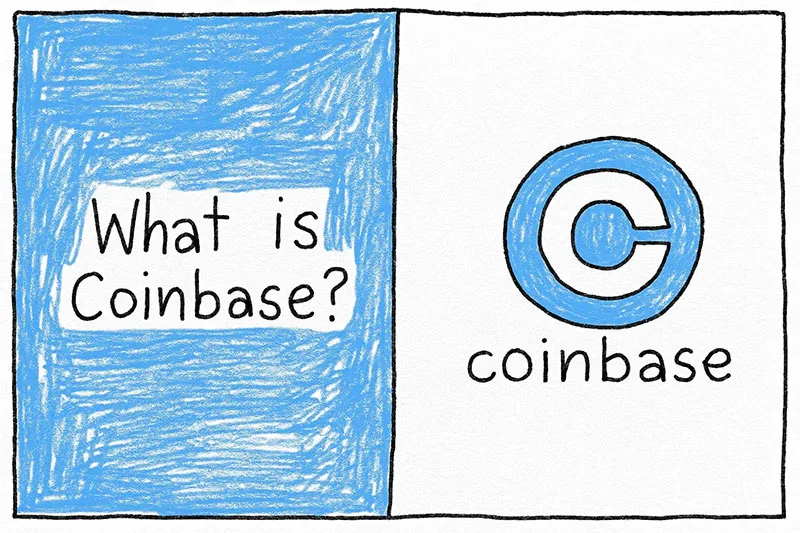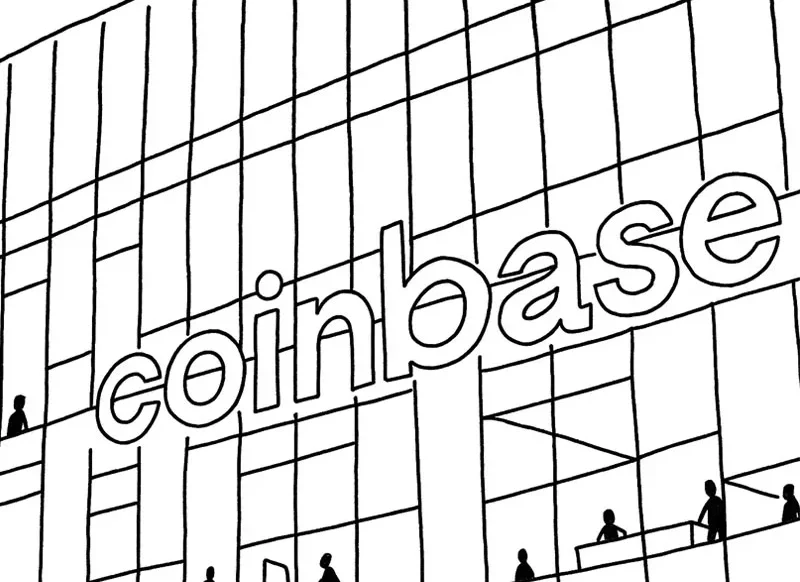Few companies in the cryptocurrency world can boast the influence and recognition that Coinbase has. The journey from a small startup in San Francisco to a publicly traded company valued at over $100 billion and the first crypto exchange in the S&P 500 is a story of vision, perseverance, and the drive to change the global financial system.
What is Coinbase?

Coinbase is a leading American publicly traded cryptocurrency company, founded in June 2012. It remains one of the largest players in the industry as of August 6, 2025, and continues to advance its mission of “increasing economic freedom in the world,” striving to become the architect of an open financial system based on principles such as accessibility, efficiency, innovation, and fairness.
Scope of Operations:
- Number of Users and Countries: Coinbase serves tens of millions of users (over 100 million, according to media reports by early 2025) and operates in more than 100 countries worldwide.
- Bitcoin Market Share: Coinbase is the world’s largest custodian of Bitcoin and also holds a significant portion of Ether and other assets.
- Assets Under Management: As of Q2 2025, the total client assets on the platform amounted to $420 billion. This aligns with the figures mentioned in your question, making Coinbase one of the largest in the U.S. by this metric.
- For comparison: At the end of Q1 2025, assets were $328 billion. However, due to market growth and an expanding client base, the latest public report for Q2 2025 shows an increase to $420 billion.
Who is behind the creation of Coinbase?

Brian Armstrong – Visionary and CEO
Brian Armstrong (born January 25, 1983, in San Jose, California) is the founder and CEO of Coinbase. His journey to creating the largest American crypto exchange began with personal experience in international payments.
Education and Early Career:
- Graduated from Rice University in Texas with a double degree in Economics and Computer Science (2005) and a Master’s in Computer Science (2006)
- Worked as a developer at IBM and a consultant at Deloitte
- Joined Airbnb as a software engineer in 2011
Moment of Revelation:
While working at Airbnb on international payments, Armstrong encountered difficulties sending money to South America. At the same time, in 2010, he came across the technical documentation of Bitcoin by Satoshi Nakamoto. “I couldn’t stop thinking about it. The idea of a decentralized, borderless currency was revolutionary,” he later recalled.
Fred Ehrsam – Co-founder and Strategist
Frederick “Fred” Ernest Ehrsam III (born May 10, 1988, in Boston) became a key partner of Armstrong in founding Coinbase.
Professional Path:
- Graduated from Duke University in 2010 with a degree in Computer Science and a minor in Economics
- Worked as a currency trader at Goldman Sachs in New York (2010-2012)
- Discovered Bitcoin through an article by a Georgetown University professor and began trading in his free time
Founders’ Introduction:
Armstrong and Ehrsam met through the Bitcoin subreddit on Reddit in 2012. Armstrong was looking for a co-founder to join the Y Combinator program, and Ehrsam responded to his post. “It was like dating,” Armstrong joked later. “I needed someone I could trust completely, someone who complemented my strengths and weaknesses.”
In 2012, Armstrong applied to the Y Combinator startup accelerator and received an investment of $150,000. Together with Ehrsam, they founded Coinbase in a two-bedroom apartment in San Francisco. The company’s name was taken from the Bitcoin whitepaper – this refers to special transactions that bring cryptocurrencies into circulation in proof-of-work blockchains.
What goal do the founders pursue?

In 2025, Brian Armstrong continues to make public statements about the company’s goal of becoming the leading global financial services platform and a driver of mass crypto adoption. Coinbase views blockchain assets not only as speculative tools but also as the foundation for future financial infrastructure (fast, borderless, efficient payments).
- According to Armstrong and industry analysts, the development of institutional products and the rise of regulation mark the beginning of a “new era” of crypto finance, where Coinbase is set to play a key role.
His ambitious vision knows no bounds. In February 2025, Armstrong made an even bolder prediction: by 2030, up to 10% of global GDP will be based on cryptocurrencies. He stated that this would mean the tokenization of more than $10 trillion in economic value.
“Onchain is the new online”, Armstrong said, comparing the current wave of blockchain adoption to the early 2000s internet boom. He sees the U.S. as the leader of this transformation, thanks to “the most pro-crypto Congress in history.”
Coinbase focuses on three pillars of its strategy:
- Crypto Investments – the core product and foundation for the growth of the crypto economy
- Updated Financial Services – building a new financial system from the ground up
- Next-Generation Applications – a platform for next-generation internet applications
What challenges do they face?

2017 Crisis:
In May-June 2017, when the price of Ethereum spiked dramatically, Coinbase’s traffic exceeded the planned maximum by five times. The platform experienced regular outages due to the infrastructure’s inability to handle such heavy traffic.
The engineering team worked around the clock, optimizing MongoDB, adding caching, and separating hot collections into separate clusters. However, in December 2017, during the record growth of Bitcoin, the problems reoccurred with even greater intensity.
Recent Incidents:
- August 5, 2025: The first network outage of Base in two years, lasting 29 minutes, due to a technical error “unsafe head delay.” This means a key component of the network responsible for confirming and producing new blocks failed to correctly update the “head block,” leading to a complete halt in chain confirmations and the issuance of new blocks. As a result, all network-related operations were blocked.
- 2025: Issues with Solana deposits, delays of up to 17+ hours due to system unpreparedness for a surge in activity.
Battle with the SEC:
In June 2023, the Securities and Exchange Commission (SEC) filed a lawsuit against Coinbase, accusing the company of operating illegally as an exchange, broker, and clearing organization without the proper registrations.
The SEC claimed that Coinbase was illegally earning billions of dollars by offering crypto assets that were “unregistered securities.” The legal proceedings lasted nearly two years.
Victory in February 2025:
On February 21, 2025, Coinbase announced that the SEC had agreed to drop the case without fines or changes to the business model. “This is a complete victory,” said the company’s Chief Legal Officer, Paul Grewal.
Major Leak in May 2025:
In May 2025, Coinbase experienced a serious cyberattack affecting 69,461 users. Criminals bribed support staff in India to gain access to personal data.
Compromised Information:
- Names, addresses, phone numbers, emails
- Images of government-issued IDs
- Last four digits of Social Security numbers
- Masked bank account numbers
- Account balance snapshots and transaction history
The criminals demanded a $20 million ransom, but Coinbase refused to pay, offering a $20 million reward for information leading to the arrest of the perpetrators. Expected settlement costs are estimated to range between $180-400 million.
Products and New Developments

Flagship Product: Coinbase Exchange
Coinbase Exchange remains the core of the company’s business, offering a comprehensive trading platform with impressive capabilities. The platform supports trading in over 300 cryptocurrencies and offers more than 400 trading pairs. The system is designed to serve both beginner and experienced traders.
They became the first CFTC-regulated exchange in the U.S., offering round-the-clock Bitcoin and Ethereum futures trading. Since May 2025, the platform expanded this feature, including 24/7 trading for BTC and ETH futures, reflecting the continuous nature of cryptocurrency markets.
In 2025, Coinbase also launched perpetual-style futures in the U.S. – a product that was previously unavailable to American traders. These contracts offer simplified expiration dates, efficient capital usage, and long-term execution strategies.
Base Network — Own Blockchain
Base is a Layer 2 solution for Ethereum, officially launched on August 9, 2023. The blockchain is built on the OP Stack from Optimism, ensuring compatibility with the Ethereum Virtual Machine (EVM) and allowing developers to easily port their applications.
Key technical features of Base include:
- Transaction Speed: Block time reduced from 2 seconds to 200 milliseconds thanks to Flashblocks technology
- Cost: Transactions are 10 times cheaper than in the Ethereum mainnet
- Security: Uses Ethereum mainnet security for transaction finality
Impressive Growth Metrics
Base has shown outstanding growth metrics, confirming the success of Coinbase’s strategy:
Total Value Locked (TVL): $4.2 billion, making Base the second-largest Layer 2 after Arbitrum. Over the year, TVL has grown by 370%.
User Activity: Over 1.17 million active addresses daily, growing by 2,100% over the year. Over 9.13 million transactions are processed daily.
Developed Ecosystem
Base supports over 364 protocols, including key projects:
Aerodrome Finance: Leading automated market maker (AMM) with TVL over $1 billion, accounting for more than 50% of Base’s total TVL.
Other notable projects: Includes Aave, Uniswap, Curve, Chainlink, and many other DeFi protocols.
Token Creation Leadership
In 2025, Base surpassed Solana in the number of tokens created per day for the first time. On July 27, Base recorded a record of 54,341 new tokens in a day, while Solana created 25,460. This growth was driven by the integration of Zora and Farcaster protocols into the Base ecosystem.
Base App – Revolutionary “All-in-One” App
On July 16, 2025, Coinbase introduced a radical transformation of its product – Coinbase Wallet was rebranded and relaunched as the Base App. This app represents an attempt to create a cryptocurrency “super app,” combining numerous features into a single platform.
Key Features
- Social Network based on Farcaster: The app integrates the decentralized social protocol Farcaster, allowing users to create content, tokenize posts via the Zora protocol, and earn rewards for their activity.
- Real-Time Trading: Users can track their friends’ trades in real-time and exchange tokens directly in the social feed, eliminating the need to switch between different apps.
- Base Pay – Instant Payments: The new payment system supports instant USDC transactions via NFC technology with a single tap. Integration with Shopify is already live, and a 1% cashback is planned for U.S. customers.
- Mini-Apps: The platform supports hundreds of built-in mini-apps – from games and AI chatbots to DeFi tools and prediction markets.
- Encrypted Communication: The XMTP protocol is used for peer-to-peer messaging, financial transactions, and interaction with AI agents.
AI Integrations and AgentKit
Coinbase AgentKit – The Framework of the Future
In November 2024, Coinbase launched AgentKit, a powerful framework for creating AI agents with crypto functionality. This tool serves as a bridge between artificial intelligence and blockchain technologies.
Key features of AgentKit:
- Model Flexibility: Support for multiple LLM providers, including OpenAI, Anthropic Claude, and Llama
- Built-in Onchain Functionality: Native access to blockchain operations through the Coinbase Developer Platform SDK
- LangChain Compatibility: Full support for LangChain and its extensive ecosystem of tools
Practical applications:
- Automatic market monitoring and trade execution based on market conditions
- Deployment and management of smart contracts without human intervention
- Processing complex DeFi operations with intelligent analysis
Partnership with Perplexity AI
Strategic Partnership
In July 2025, Coinbase entered a strategic partnership with Perplexity AI, an AI search engine that answers user queries with cited real-time data.
Two-Phase Integration
Phase 1: Integration of Coinbase market data, including the COIN50 index, into Perplexity’s Comet browser for market analytics. Users can analyze price movements with deeper context.
Phase 2: Direct integration of data into Perplexity’s conversational AI, allowing users to ask natural language questions about the cryptocurrency market and receive answers based on live Coinbase data.
Strategic Importance
Coinbase CEO Brian Armstrong expressed confidence that the intersection of AI and cryptocurrency would bring exponential value to both industries: “I expect that enhanced crypto functionality will be the catalyst for another tenfold leap in AI.”
Institutional Products
Coinbase Prime – Flagship for Institutions
Coinbase Prime is a comprehensive institutional platform that serves over 13,000 clients, including hedge funds, asset managers, financial institutions, and corporate treasuries.
Integrated Solutions:
- Trading: Access to multiple exchanges and liquidity venues through a single smart order router
- Custody: Secure storage of over 420 assets using Coinbase Vault technology
- Financing: Comprehensive solutions for lending, margin trading, and short positions
- Staking: Support for staking over 15 assets directly from cold storage
Partnership with BlackRock
Coinbase is a key partner of BlackRock, the world’s largest asset manager. BlackRock’s Aladdin platform is integrated with Coinbase Prime, providing institutional clients direct access to cryptocurrency markets.
Significance of the Partnership:
- BlackRock manages assets worth over $10 trillion
- Coinbase serves as the custodian for 9 of 11 spot Bitcoin ETFs and 8 of 9 Ethereum ETFs
- The integration allows clients to manage crypto exposure within existing portfolios
Advanced Security Technologies
Coinbase utilizes military-grade security technologies, becoming the first crypto custodian to deploy Cross Domain Solution (CDS) systems – a technology approved by the NSA and NCSC UK for military and critical infrastructure.
Key Security Measures:
- Multi-Party Computation (MPC): Private keys are never stored entirely and are not fully recoverable
- Geographic Distribution: Key shares are distributed across multiple secure environments
- Automated Risk Analysis: Every transaction undergoes automated checks before execution
Conclusion: Coinbase’s product ecosystem represents a comprehensive platform evolving from a simple crypto exchange to a full-fledged financial service provider. From its primary trading platform to advanced AI integrations, its proprietary blockchain, and institutional-grade corporate solutions, Coinbase is building the infrastructure for the future of the decentralized economy.
Advantages Over Competitors

Regulatory Superiority of Coinbase
Coinbase’s regulatory superiority is evident in its unique position as the only major crypto exchange that is a publicly traded company with licenses in over 100 jurisdictions. The company not only complies with SEC, CFTC, and FinCEN requirements but actively shapes the regulatory landscape of the industry. The acquisition of the MiCA license in Luxembourg provided access to serve all 27 EU countries, while FDIC insurance for USD deposits for U.S. users creates an additional layer of trust, unavailable to most competitors.
Security Focus
Security issues are central to Coinbase’s strategy, especially after the significant incident in May 2025, when the company experienced a data breach affecting over 69,000 users. Hackers bribed customer support staff in India to gain access to personal client data, including names, addresses, Social Security numbers, and account balances. The damage was estimated between $180-400 million, and the criminals demanded a $20 million ransom, which the company refused to pay. Although painful for the reputation, this incident demonstrated Coinbase’s commitment to security principles and its willingness to absorb financial losses to protect clients. Despite the breach, 98% of client funds remain in isolated cold storage, secured with AES-256 encryption and mandatory two-factor authentication.
Financial Performance
Coinbase’s financial performance demonstrates the resilience of its business model, even amid market volatility. In Q2 2025, the company reported revenues of $1.5 billion, a 3.4% increase over the previous year. Particularly impressive was the 9% growth in subscription and services revenues, reaching $655.8 million, with stablecoin revenue rising 38% to $332.5 million, thanks to a strategic partnership with Circle. The company holds $9.3 billion in dollar reserves, ensuring financial stability and opportunities for further investment in innovation.
Strategic Acquisition of Deribit
The $2.9 billion acquisition of Deribit represents the largest deal in the crypto industry’s history and significantly strengthens Coinbase’s position in the derivatives market. Deribit facilitates $1 trillion in annual trading volume and $30 billion in open interest, making it the market leader in cryptocurrency options. This acquisition not only broadens Coinbase’s product offering but also opens up new growth opportunities in international markets.
Global Expansion
Coinbase’s global expansion is accelerating, particularly in the Asia-Pacific region, where demand for regulated crypto products is growing exponentially. Coinbase International Exchange has become the cornerstone of this expansion, providing a secure and compliant platform for trading perpetual futures. In 2024, the listing of 91 new assets expanded support to over 90% of the perpetual futures market, with daily volume increasing by more than 6200%.
Competitive Advantages
Coinbase’s competitive advantages become particularly apparent when compared to its main competitors. In relation to Binance, Coinbase excels in regulatory compliance, user trust, customer support quality, and educational resources. Its proprietary blockchain and ecosystem approach create a unique competitive edge, although higher fees remain a drawback. Compared to Kraken, Coinbase leads in ease of use, mobile applications, and educational programs for beginners, offering a broader selection of trading pairs but lagging in advanced trading tools.
Challenges and Opportunities
Despite challenges – from technical failures to regulatory battles, from cyberattacks to criticism of high fees – Coinbase continues to solidify its position as a leader. Victory over the SEC, inclusion in the S&P 500, the success of Base Network, and the launch of Base App demonstrate the company’s ability to adapt and thrive.
For the average user, choosing Coinbase means betting on the future, where cryptocurrencies will become an integral part of everyday financial operations. It is a choice of a platform that not only provides services today but is also building the infrastructure of tomorrow.
In a world where economic freedom is becoming an increasingly important value, Coinbase offers tools to achieve it – from simply buying your first Bitcoin to creating complex DeFi applications on Base. The company’s mission to increase economic freedom globally is no longer just a marketing slogan but a measurable reality for millions of users worldwide.

